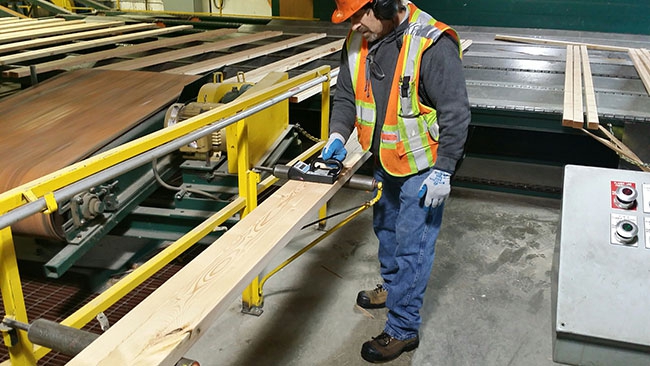
Features
Harvesting
Logging Profiles
Managing moisture: The Kalesnikoff Lumber Company
Nov. 25, 2016 - The Kalesnikoff Lumber Company has come a long way since brothers Sam and Peter Kalesnikoff started up the company in 1939 as a way to work their way out of poverty caused by The Great Depression.
November 22, 2016 By Andrew Snook
 Kalesnikoff Lumber Company employees check the moisture content of every charge with their handheld moisture meters and stack probe over the charge’s run duration to ensure that all drying targets are met. The Kalesnikoff Lumber Company has come a long way
Kalesnikoff Lumber Company employees check the moisture content of every charge with their handheld moisture meters and stack probe over the charge’s run duration to ensure that all drying targets are met. The Kalesnikoff Lumber Company has come a long wayThe family business originally started out as a bush mill cutting about 3,000 FBM per day, cutting lumber that was in demand but only available in limited supplies, such as 22-foot and 24-foot long 2x6s, 2x8s, 2x10s, and 2x12s.
The company grew steadily over time but really began to expand in 1977, when Ken Kalesnikoff – the current president of the company and third-generation of Kalesnikoffs involved in the family business – was asked by his father, Peter Jr., to try his hand at the lumber selling side of the business. Ken quickly identified the increasing demand for specialty wood products and the potential opportunities for growth that demand could create for his family’s mill operations.
“My dad just touched the tip of the iceberg as far as specialty products were concerned,” Ken says. “I noticed the lumber we sold to other companies was being used to make high-end, value-added specialty products. For instance, our 2x6s were being used to make 1×6 paneling and some of our Douglas fir was being made into flooring. It was the same with all our products.”
Fast-forward to present day, and the family-run specialty sawmill based in Thrums, B.C., about a 10-minute drive from Castlegar, produces more than 400,000 FBM per day and over 1,500 different products in both custom and dimensional sizes.
MC is key
The Kalesnikoffs always knew that a key to successfully producing high-end wood products was to have proper drying procedures in place to ensure the correct moisture content levels (MC). In 1985, they built the first of five state-of-the-art natural gas and steam-injection dry kilns to dry the mill’s high-end specialty items; including its cornerstone product, lamstock, as well as flooring, paneling, siding, moldings, and furniture-grade materials.
“MC on dimensional lumber isn’t as critical as with specialty products. For instance, wet lamstock used in the gluing process will produce a beam that would dry, crack, and come apart. The client would be very unhappy and that would then affect us,” Ken explains.
The company started out using pin moisture meters in their kilns, but found them to be inefficient and unreliable, so they invested in Wagner Meter’s L612 and L622 handheld meters, and the L722 stack probe to perform in-kiln moisture checks.
“Drying is an art. If you’re not careful, you can easily over-dry or under-dry lumber,” Ken says. “Our slow drying schedule is measured in days or weeks and, along with the Wagner meters, helps us achieve better quality. This also enables us to consistently achieve optimum MC, which is critical to our business.”
The mill proactively checks the MC of every charge with its handheld meters and stack probe over its run duration to ensure that all drying targets are met.
“The Wagner meters save us time and money, and are vital in helping us protect grade value,” says Brad Mason, manufacturing team lead for Kalesnikoff Lumber. “Conservatively, I’d estimate that we gain around two to three per cent of our kiln dried volumes into our specialty grades with the use of the Wagner meters.”
Mason says that the L622 meter helps improve several efficiencies in the mill’s drying processes.
“It provides us with an informative report summary that can be effectively used in helping determine the required drying needs of our lumber at any given time,” he says. “And with the meter’s ability to store numerous grouped readings in its memory, our kiln operators find success with managing multiple kiln audits at any one time. The Wagner meters provide us these advantages, while doing it on a very user-friendly and reliable platform.”
With so many different products being created, it’s no surprise that the Kalesnikoff mill is used to drying a wide variety of species in its kilns. Of those species, larch and hemlock provide special challenges due to their large variability in pre-kiln MC, says Tony Morgan, senior technician for Wagner Meters.
“Since they don’t have the ability to green sort in their sawmill, they are forced with trying to effectively kiln dry these runs while managing the potential for over-dried lumber,” Morgan explains. “To help them achieve their objective of getting the vast majority of pieces under their MC threshold, the kiln operators will conduct anywhere from one to four moisture checks with the stack probe at the tail end of each charge to prevent the chance of over-drying.”
“Moisture management is extremely critical for us, especially in our kilns. Without a doubt, it’s what helps us produce quality lumber consistently, efficiently and profitably,” Mason adds.
Through effectively managing the MC of every charge that enters its kilns, Kalesnikoff Lumber is ensuring a high standard is met for its wide variety of specialty wood products, while building a bright future for the next generation of Kalesnikoffs and the mill’s employees.
Print this page